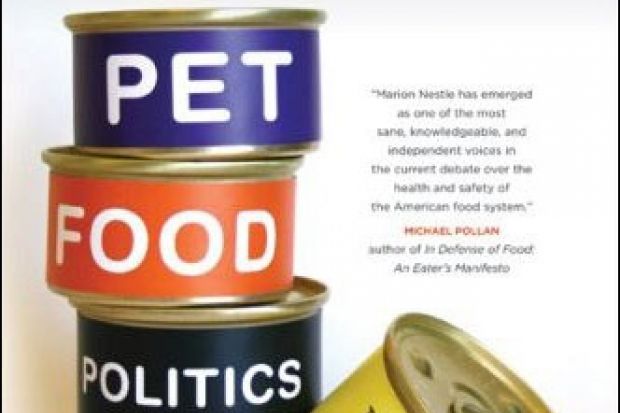For two months, from March 2007, a significant number of leading dog- and cat-food manufacturers recalled products from retailers. The products included those brands familiar to consumers in the UK, including those at the costly end of the market such as Eukanuba, Iams and Royal Canin.
This was the largest recall of consumer products in US history. In the aftermath, as many as 5,000 canine and feline animal companions were found to have died from kidney failure owing to a toxic chemical cocktail in their food. US pet owners' faith in many pet food manufacturers had been shaken, and contamination had been traced back through the supply chain, revealing connections in the sources for pet food and products fed to agricultural animals, including the animals "grown" for meat, milk and eggs to be consumed by humans. In China, where the toxic compounds were inserted into the pet food supply chain, Zeng Xiaoyu, the former head of China's State Food and Drug Administration, was executed. In the US, pet food sales fell by 30 per cent and animal advocates aimed to "take pet liability damages into the stratospheric heights of compensation for human liability".
This is the story told by Marion Nestle, a professor of sociology, nutrition and public health at New York University and author of several commercially popular and academically well-received books about the food industry. Nestle's Pet Food Politics provides a detailed and vivid account of the unsavoury processes that led to the recall and examines its implications for all consumers, rather than as "merely" a problem for cats, dogs and their human companions. The book reads like a detective story, plotting the sequence of events from the recall and tracing the poisoned food back through the "interconnected, multinational system of food production, distribution and consumption" of which the multibillion-pound pet food industry is a part.
The food industry routinely uses cost-cutting initiatives and, in recent history, adding waste products from one kind of industrial process such as melamine manufacture, to boost nitrogen levels in animal feed, baby milk and children's food products for example, has been common. However, it was the effect of combining melamine with cyranic acid, another nitrogen-rich cheap chemical, which produced crystals in animals' urine and precipitated rapid and fatal kidney damage. The outbreak was caused by adulterated wheat gluten and rice-protein concentrate from China.
Most alarming for some readers will be the account of the way in which these contaminants found their way into the human food chain. Pet food that is "salvaged" from the production process is commonly fed to chickens and pigs, and wheat gluten and rice protein concentrate also goes into feed for fish and farm animals. Nestle shows that pet food was a part of the general food-supply system characterised by problems of contamination and an inability by regulatory bodies to effectively monitor such large and complicated networks.
She is strongly critical of journalists and company representatives who dismissed the early stages of the crisis in terms of pet owners making a fuss over a few dead and dying cats and dogs. Rather, she argues for an overhaul of the food inspection system on the grounds that "policies good enough to protect pets also means advocacy for policies that protect people". Nestle has little time for the regulators and the directors of companies who were reluctant to examine the causes of the problem and to recall their products. This lack of sympathy for overly defensive producers has earned Nestle the derision of corporate interest groups and some consumer forums in the US.
The book appears to be aimed at pet lovers. Nestle is shown in the jacket photograph hugging a dog, and there are endorsements on the back cover from the editors of Whole Dog Journal and The Bark. Nestle shows the strength of feeling that the "pet community" have for their pets - jamming veterinary surgeries and phone lines, setting up internet sites and ultimately a "Good Pet Food" movement to join the list of social movements in food advocacy. Yet it is revealing that the pristine Samoyed dog pictured with Nestle on the cover has been hired for the photograph. Nestle appeals to the pet owner as a knowledgeable voice helping to secure the well-being of their pet - much, in fact, as pet food advertisers do.
The book's purpose has little to do with animal advocacy, but it uses the pet-food recall to highlight the connections between the food supplies of humans, farm animals and pets, thereby emphasising the broader failings of food regulation. The global food-production system is not cast as the villain, although Nestle implies that a local approach to making pet food would be safer and says that the "need for an outlet for the leftovers of animal slaughter is one of the reasons pet food exists".
Yet the politics of the meat industry and animal food is never critically considered in terms of its impact on animal welfare, human health or the environment and Nestle's heroes are the scientists who trace contamination, often through vivisection. She concludes with a demand for an overhaul of America's regulatory regime to reflect the interconnected nature and huge scale of contemporary food-supply systems for humans and animals. This is a worthy book about food safety, but disappoints those who would like to see a transformation in the food system itself.
Pet Food Politics: The Chihuahua in the Coal Mine
By Marion Nestle
University of California Press 232pp, £11.50
ISBN 9780520257818
Published 1 September 2008
